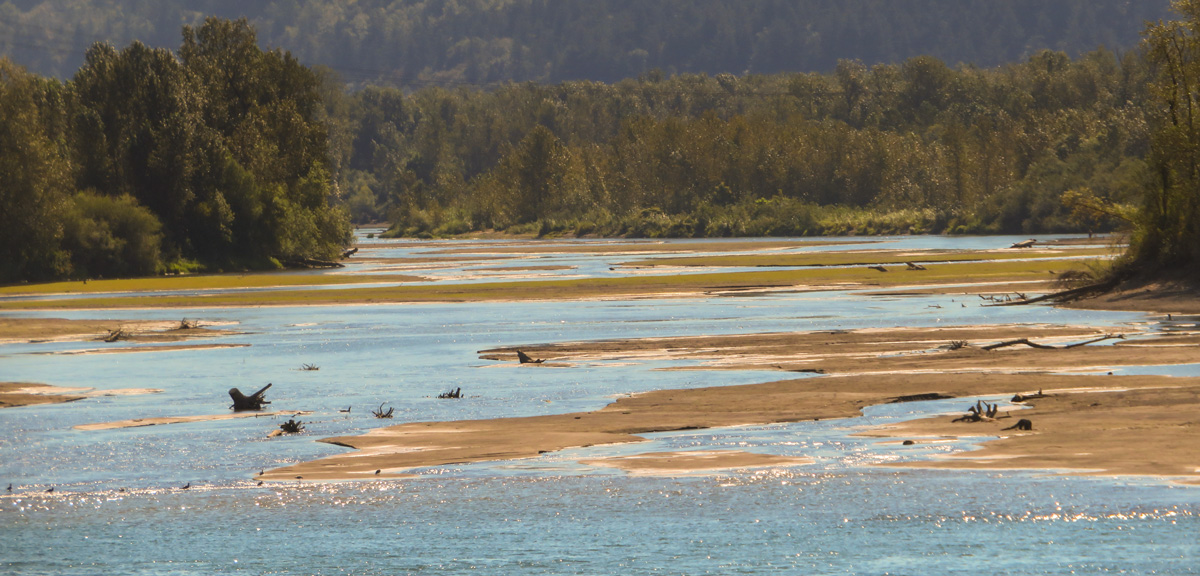Government Island, Portland, OR Walking on the southern shore, Clark is unable to cross a river full of quicksand. The boats continue to a large island full of ponds and enjoy a “Sumptuous Supper” of swans, brant, and ducks. In Philadelphia, Charles Willson Peale observes two of Lewis’s animal specimens.
Foggy Morning and Quicksand[1]Originally aired weekdays by Yellowstone Public Radio during the Bicentennial observance of 2003-2006. Narrated by Hal Hansen. Scripts by Whit Hansen and Ed Jacobson. Produced by Leni Holliman. © … Continue reading
Quicksand River
I arrived at the enterance of a river [Sandy River] which appeared to Scatter over a Sand bar, the bottom of which I could See quite across and did not appear to be 4 Inches deep in any part; I attempted to wade this Stream and to my astonishment found the bottom a quick Sand, and impassable—
—William Clark
Foggy Morning
The Fog So thick this morning that we could not See a man 50 Steps off, this fog detained us untill 10 oClock at which time we Set out, accompanied by our Indian friends who are from a village near the great falls
—William Clark
Mt. Hood
we Saw the round mountain some distance a head which we expect is the Same which was discovred by Lieut. Hood and is called Hoods Mountain.
—John Ordway
Shoshone Prisoner
a Canoe arrived from the village below the last rapid with a man his wife and 3 children, and a woman whome had been taken prisoner from the Snake Inds. on Clarks River I Sent the Interpreters wife Sacagawea who is a So So ne [Shoshone] or Snake Indian of the Missouri, to Speake to this Squar, they Could not understand each other Sufficiently to Converse.
—William Clark
Government Island Camp
we came 13 miles this day and Camped on a verry large Island which is mostly prarie and large ponds, which is full of Swan Geese brants and ducks &C. Several Indians Camped with us. at Sunset we got a small canoe and carried in the pond Several Swan geese and brants killed by the party to day and this evening.—
—John Ordway
Immense Numbers
river wide and emence numbers of fowls flying in every direction Such as Swan, geese, Brants, Cranes, Stalks [Storks], white guls, comerants & plevers &c. also great numbers of Sea Otter in the river—
—William Clark
Weather Diary
Day of the month Wind State of the Weather 3rd N. E. fair after fog a thick fog which continud untill meridian cleared off and was fair the remainder of the day. passed the enterance of quick Sand river.
—Meriwether Lewis and William Clark[2]Some abbreviations have been spelled out.
Badger and Pronghorn
From his museum in Philadelphia, Charles Willson Peale discusses his observations of the specimens that were sent on the barge from Fort Mandan.
Museum Novr. 3d. 1805.
Dear Sir
The Badger appears to be different, at least in Buffons platte, I have not had time to examine Pennant and some other Authors who say it belongs to America, but is a scarce Animal every where.
The Antelope [pronghorn] appears to be a fine Animal, the hair considerably more like that of the Deer, than I find on the Antelopes in the Museum. The branched horns perhapes makes it a singular Animal, I dont yet see any of such description. After I have mounted these several Skins, I may be able to say more on them—they are a valuable addition to the Museum, altho’ some parts of them are in bad condition owing to the Moth & Dermest having made great havock—
I am with all due respect your friend.
C. W. Peale[3]Charles Willson Peale to Thomas Jefferson in Letters of the Lewis and Clark Expedition with Related Documents: 1783-1854, 2nd ed., ed. Donald Jackson (Urbana: University of Illinois Press, 1978), … Continue reading
Notes
| ↑1 | Originally aired weekdays by Yellowstone Public Radio during the Bicentennial observance of 2003-2006. Narrated by Hal Hansen. Scripts by Whit Hansen and Ed Jacobson. Produced by Leni Holliman. © 2003 by Yellowstone Public Radio. |
|---|---|
| ↑2 | Some abbreviations have been spelled out. |
| ↑3 | Charles Willson Peale to Thomas Jefferson in Letters of the Lewis and Clark Expedition with Related Documents: 1783-1854, 2nd ed., ed. Donald Jackson (Urbana: University of Illinois Press, 1978), 267–68. |

